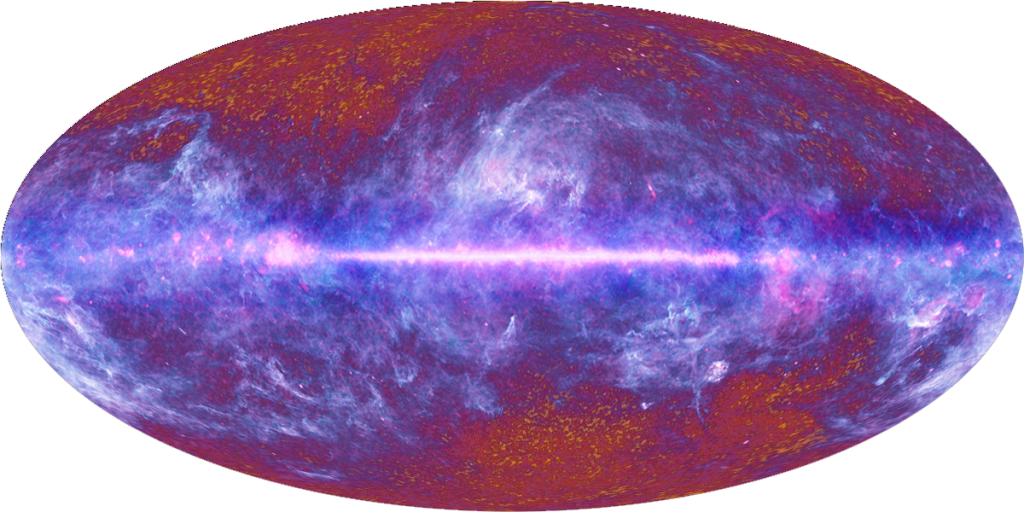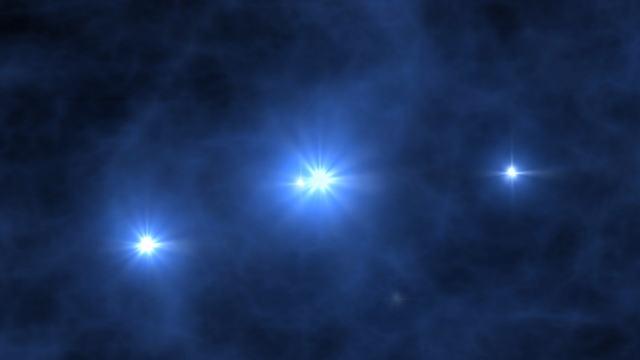One of the main challenges with looking at light from the start of the Universe is that you have to look through the rest of the Universe to see it. The Universe is a busy, messy place, and working out which bits of an image are the CMB and which are from something much closer can be tricky.To help disentangle this, Planck detects light with many different wavelengths. While the CMB is Planck’s primary science goal, the many other sources of microwave light are interesting in their own right.

The Galaxy
The most problematic object Planck needs to look through to see the CMB is our own Galaxy. The stars are not visible at millimetre wavelengths, but the gas and dust in between the stars is. The galaxy is a very complicated place, but luckily we sit in the plane of the disk and so the Milky Way appears primarily as a band across the sky. Away from this band, Planck can see though to the CMB much more clearly. By using the different wavelengths measured, the light from the Galaxy can be identified and removed form the images, so the CMB can be reconstructed. The light from the Milky Way is by no means discarded, though, and these millimetre-wavelength measurements are ideal making a map of the gas and dust in our Galaxy, which can give further clues as to its formation and structure.
Distant Galaxies
Just as the light from the CMB has been stretched over the billions of years of the Universe’s expansion, the light from the first galaxies has also been stretched. These galaxies are very far away, and so appear very small, but Planck will still see a lot of tiny objects all over the sky. The distribution of these objects, such as how many are grouped together in to clusters, can be used to investigate the content and evolution of the Universe. These galaxies will also be looked at by Planck’s sister mission, the Herschel satellite, which will look at them at slightly shorter wavelengths.
Galaxy Clusters
As well as individual galaxies, Planck can detect clusters of galaxies, each one containing hundreds or thousands of individual galaxies. It doesn’t detect the galaxies themselves, but through the Sunyaev Zel’dovich effect it sees the hot gas in the centre of the clusters. The gas is so hot that as light from the Cosmic Microwave Background passes through the clusters them and interacts with the gas, it is energised. This creates a particular effect in the Planck images, and is an excellent way of detecting galaxies at huge distances across the Universe.
The first stars
We see the CMB radiation from a time when the Universe changed from an opaque plasma, or ionised gas, to a transparent, (electrically) neutral gas. However, we know that the Universe is not completely neutral now, as stars and many nebulae are full of ionised gas. The intense radiation from stars and galaxies re-ionises the surrounding regions as they emit strong radiation. This would have first happened in isolated pockets when the first stars, which were particularly hot and bright, started burning.
However, we are not completely sure when the first stars formed, only that it was probably somewhere between 100 million and 1 billion years after the start of the Universe. Their signature is left as a subtle imprint on the CMB, and Planck will help narrow down when these first stars formed, giving further clues as to the evolution of our Universe.
The complete unknown
Some of the most fascinating discoveries in astronomy, and in fact science in general, have been made completely by chance. In fact, the very discovery of the CMB itself in the 1960s was purely by chance, due to Arno Penzias and Robert Wilson trying to identify a persistent signal which was interfering with their measurements of the Galaxy. They even cleaned out the bird droppings from their antenna in case that was causing it, before settling on an explanation much further from home! There’s no way of knowing what fascinating discoveries could be turned out by the Planck data, and there’s only one way to find out…bring on the data!

